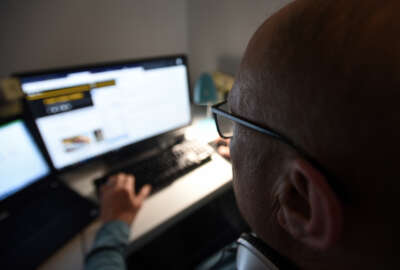
Remote work: What next?
What many don’t realize is that while remote work is still a novelty for many, if not most, it is standard-operating-procedure for an unknown number of feds. Some...
Working from home has become the new normal for millions of Americans both in government and the private sector. Some employment experts say that half the workforce in the top ten work centers — including New York City, Los Angeles and Washington, D.C. — were working from home the first week in January.
Two months into the pandemic, more feds in more occupations, locations and agencies were working from home than in the previous two decades. The arrival of COVID-19 halted Trump administration efforts to reduce the number of civil servants doing their jobs from home or remote work sites. So even as it is the new normal for many, it is still in the TBD category. The Washington Post recently reported that the administration effort to bring more workers back to the office “remains muddled.”
What many don’t realize is that while remote work is still a novelty for many, if not most, it is standard-operating-procedure for an unknown number of feds. Some of them have been doing it for years. The Patent and Trademark Office has long been the poster child for federal agencies allowing people to work from home. But many individuals have been doing it too! Today we hear from a veteran non-commuter. Abraham Grungold recently retired from federal service to become a full-time financial advisor. His time as a remote worker (five-plus years) predates the pandemic. So how is it long term? Here’s his been-there-done-that-got-the-T shirt account:
The lucky ones, working remotely
“For the past five years, I have been working remotely. Most federal employees such as Transportation Security Administration screeners, Veterans Affairs nurses and Capital Police Officers do not have these opportunities. They are the front-line employees of the government. Since the COVID-19 pandemic, I have been working from home full-time. I would like to discuss the positives, the negatives, and what the future holds.
Hey folks, I am not an IT person, just a fed who can do his job from home just as if I was sitting in my office.
Working remotely has been interesting and challenging. It is wonderful to have zero-commute time and save money on transportation and lunches. But I miss the human contact, the lunches, the annual conferences where I can exchange ideas with my peers. It is interesting that I do everything on the computer such as meetings, training and assignments. It’s challenging and annoying when there are constant problems with the internet, firewall protocols and security updates. We are paperless, no paper anywhere, but I cannot find the telephone directory or the organizational chart. Is it under the human resources page, the communications page or under my personal page? Office meetings are a challenge when I cannot hear people clearly on the Teams Video conferencing or when someone presents a PowerPoint presentation with a tiny font. I find it amusing that top management always says ‘I came into the office for today’s meeting because my internet does not work well at home.’ Come on, it is the Metropolitan D.C. area, not Wyoming.
So what will the future bring, or what will I wish for? In the near future, I see a mixture of employees given the option to work remotely or working in the office. I converted my man cave into a man cave with a workstation. Not every fed has that extra space. Heavy computer users need two monitors and an ergonomic chair, etc. I try to fit it in with my sports memorabilia. If 25% of the government could work remotely, maybe it will alleviate some of the traffic and save the environment of carbon emissions. The pandemic has forced the government to be creative with new methods to improve working from home, starting with new employee policies, new software and plenty of training. But the greatest benefit of working from home is not having to take leave to care for a sick child or take annual leave to wait for the plumber to fix a leak. Unfortunately, in 2020, I underwent several surgeries and a battery of treatments and testing. Instead of taking several months of sick leave, I was able to work most days, taking a day off here and there or an afternoon off instead of missing an entire day. Working remotely allowed me to be productive even though I did not feel well, or I was fearful of driving myself to the office because of side effects from my medications.
The future always makes me think of the Jetsons. Their technology was better than Star Trek. Everything moves fast and efficiently. Could a team meeting have everyone in a virtual room, and you can see everyone around you? People entering and leaving the room, you can see them coming in the virtual room and find a spot in the circle. I suppose the government would have to buy everyone an Oculus device to make that happen. I would love to see my monitor projected to the wall like the old TV projection screen, so I can watch meetings on a large scale and the PowerPoint presentation will be easier to read. Most of all, I would like to hear and see everyone clearly on the video conferences. I would be happy with the basics on a high-quality scale. Entering a database usually takes JAVA updating, two-step authentication and other hurdles. Perhaps a retina identification could eliminate all the steps. Can you imagine if you could wear a helmet that would replace your mouse and typing a document would happen just by thinking about it? It is possible we could see that in 10 years.
Due to the pandemic, my part-time business as a financial coach has been extremely busy. During, 2021, it has grown 500% due to the Zoom teleconferencing program. I have federal clients all over the U.S. and abroad. It is better than driving to Starbucks, hoping to find a good table, sitting, and waiting. When we meet, I no longer worry about eaves dropping to our conversation or being interrupted by someone that recognizes me. Any improvements with the quality of Zoom and FaceTime would be a plus.
Any questions or comments, please contact me at Grungold LinkedIn or my Facebook page at FERS Federal Employees.
Nearly Useless Factoid
Spacely’s Space Sprockets, the company George Jetson worked for, would be worth $1.3 billion in sales in today’s market after factoring in inflation, according to Forbes, making it number 25 on the magazine’s list of most valuable fictional companies. The Combine Honnete Ober Advancer Mercantiles (CHOAM), the company that controlled distribution of the spice melange in Dune, came in first place with a total worth of $1.7 trillion.
Source: Forbes
Copyright © 2025 Federal News Network. All rights reserved. This website is not intended for users located within the European Economic Area.
Mike Causey is senior correspondent for Federal News Network and writes his daily Federal Report column on federal employees’ pay, benefits and retirement.
Follow @mcauseyWFED
Related Stories





